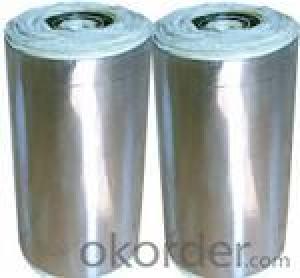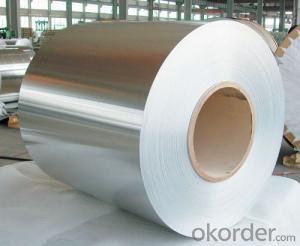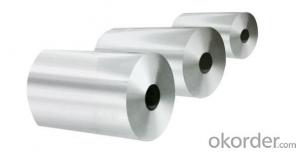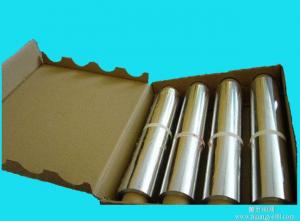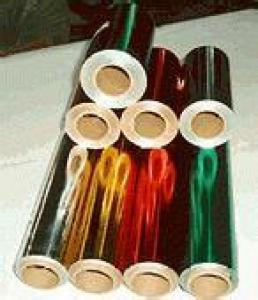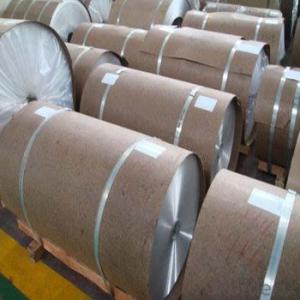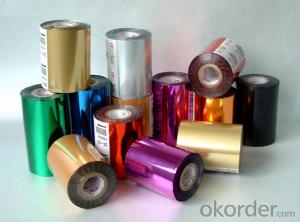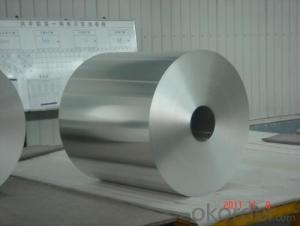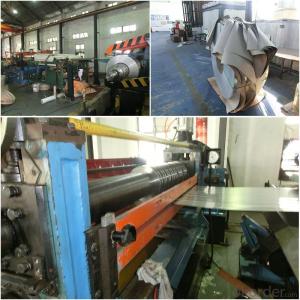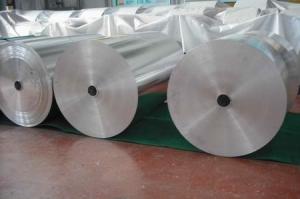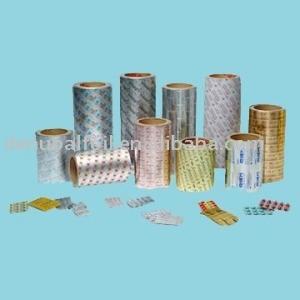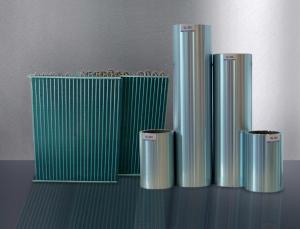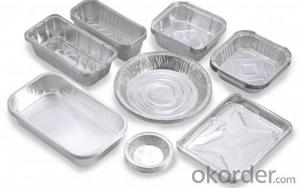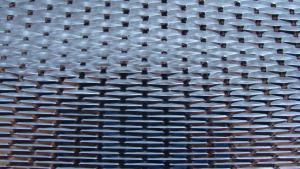Aluminum foil for more use
- Loading Port:
- China Main Port
- Payment Terms:
- TT OR LC
- Min Order Qty:
- -
- Supply Capability:
- -
OKorder Service Pledge
OKorder Financial Service
You Might Also Like
Aluminium foil acts as a total barrier to light and oxygen (which cause fats to oxidise or become rancid), odours and flavours, moistness, and germs, it is used broadly in food and pharmaceutical packaging. The purpose of aluminium is to make long-life packs (aseptic processing|aseptic packaging) for drinks and dairy goods, which allows storing without refrigeration. Aluminium foil containers and trays are used to bake pies and to pack takeaway meals, ready snacks and long life pet foods.
Aluminium foil is widely sold into the consumer market, often in rolls of 500 mm (20 in) width and several metres in length.It is used for wrapping food in order to preserve it, for example, when storing leftover food in a refrigerator (where it serves the additional purpose of preventing odour exchange), when taking sandwiches on a journey, or when selling some kinds of take-away or fast food. Tex-Mex restaurants in the United States, for example, typically provide take-away burritos wrapped in aluminium foil.
Aluminium foils thicker than 25 μm (1 mil) are impermeable to oxygen and water. Foils thinner than this become slightly permeable due to minute pinholes caused by the production process.
Aluminium foil has a shiny side and a matte side. The shiny side is produced when the aluminium is rolled during the final pass. It is difficult to produce rollers with a gap fine enough to cope with the foil gauge, therefore, for the final pass, two sheets are rolled at the same time, doubling the thickness of the gauge at entry to the rollers. When the sheets are later separated, the inside surface is dull, and the outside surface is shiny. This difference in the finish has led to the perception that favouring a side has an effect when cooking. While many believe that the different properties keep heat out when wrapped with the shiny finish facing out, and keep heat in with the shiny finish facing inwards, the actual difference is imperceptible without instrumentation.The reflectivity of bright aluminium foil is 88% while dull embossed foil is about 80%.
We provide a full range of precision aluminum strip for almost any application. We produce aluminum strip in a wide variety of alloys, including clad composites. Our aluminum strip can be produced in standard dimensions or custom made to your special requirements. We produce both imperial and metric units. We manufacture in compliance with the main international specifications, and tighter tolerances or custom tempers are available upon request. We offer various surface conditions, custom finishes (painting, anodizing, embossing), special processing, and multiple packaging options to meet our customer's unique requirements. The following is a summary of our capabilities.
Manufactured in compliance with the main international specifications and standards, including: Aluminum Association, ASTM, EN, and DIN.
We can also manufacture in compliance with other international standards including:ASME, SAE, AMS, AWS, FED, MIL, QQ, ISO, BS, AFNOR, JIS and GOST.
Manufactured in compliance with the main international specifications and standards.
Tighter tolerances are available upon request.
Aluminium (or aluminum; see spelling differences) is a chemical element in the boron group with symbol Al and atomic number 13. It is a silvery white, soft, ductile metal. Aluminium is the third most abundant element (after oxygen and silicon), and the most abundant metal in the Earth's crust. It makes up about 8% by weight of the Earth's solid surface. Aluminium metal is so chemically reactive that native specimens are rare and limited to extreme reducing environments. Instead, it is found combined in over 270 different minerals.The chief ore of aluminium is bauxite.
Aluminium is remarkable for the metal's low density and for its ability to resist corrosion due to the phenomenon of passivation. Structural components made from aluminium and its alloys are vital to the aerospace industry and are important in other areas of transportation and structural materials. The most useful compounds of aluminium, at least on a weight basis, are the oxides and sulfates.
Despite its prevalence in the environment, no known form of life uses aluminium salts metabolically. In keeping with its pervasiveness, aluminium is well tolerated by plants and animals. Owing to their prevalence, potential beneficial (or otherwise) biological roles of aluminium compounds are of continuing interest.
The earliest citation given in the Oxford English Dictionary for any word used as a name for this element is alumium, which British chemist and inventor Humphry Davy employed in 1808 for the metal he was trying to isolate electrolytically from the mineral alumina. The citation is from the journal Philosophical Transactions of the Royal Society of London: "Had I been so fortunate as to have obtained more certain evidences on this subject, and to have procured the metallic substances I was in search of, I should have proposed for them the names of silicium, alumium, zirconium, and glucium."
Davy settled on aluminum by the time he published his 1812 book Chemical Philosophy: "This substance appears to contain a peculiar metal, but as yet Aluminum has not been obtained in a perfectly free state, though alloys of it with other metalline substances have been procured sufficiently distinct to indicate the probable nature of alumina."[69] But the same year, an anonymous contributor to the Quarterly Review, a British political-literary journal, in a review of Davy's book, objected to aluminum and proposed the name aluminium, "for so we shall take the liberty of writing the word, in preference to aluminum, which has a less classical sound."
The -ium suffix conformed to the precedent set in other newly discovered elements of the time: potassium, sodium, magnesium, calcium, and strontium (all of which Davy isolated himself). Nevertheless, -um spellings for elements were not unknown at the time, as for example platinum, known to Europeans since the 16th century, molybdenum, discovered in 1778, and tantalum, discovered in 1802. The -um suffix is consistent with the universal spelling alumina for the oxide (as opposed to aluminia), as lanthana is the oxide of lanthanum, and magnesia, ceria, and thoria are the oxides of magnesium, cerium, and thorium respectively.
The aluminum spelling is used in the Webster's Dictionary of 1828. In his advertising handbill for his new electrolytic method of producing the metal in 1892, Charles Martin Hall used the -um spelling, despite his constant use of the -ium spelling in all the patents[58] he filed between 1886 and 1903. It has consequently been suggested[by whom?] that the spelling reflects an easier-to-pronounce word with one fewer syllable, or that the spelling on the flyer was a mistake.[citation needed] Hall's domination of production of the metal ensured that aluminum became the standard English spelling in North America.
- Q:How fast will it go?I'm not familiar with knots so please answer in MPHThank you.
- About 22 - 24 mph average cruise speed Nothing magic about knots to mph - just remember 10 knots is about 11 miles per hour (rounded off) - 20 knots is about 22 mph, and 22 mph is about how fast your boat will go (maybe 23 or 24) - depending on the load or weight the boat is carryingThere isn't much difference in mph knots at low speeds Techinically, 1 knot 1.15 mph
- Q:I know the best way to cook chicken wings is on the grill, but at the moment it's not possibleDo I cook them first and then put the sauce on? Do I cook it the same way I cook chicken breasts or thighs? Help, please.
- here ya go, just follow this recipe 2 tspsoy sauce 2 tspdry sherry 12 chicken wings 3-1/2 Tbsteriyaki sauce 1 large clove garlic, pressed 1-1/4 tspsesame seeds, toasted, optional aluminum foil Preheat oven to 425°FCombine first 2 ingredients in bowlAdd chicken and mix to coat all pieces wellArrange chicken in a single layer on rack in large foil-lined baking panBake 30 minutesCombine teriyaki and garlic in a bowlBrush half of mixture over chickenTurn over and brush with remaining mixtureBake 15 minutes longer or until tenderSprinkle with sesame seeds, if desired.
- Q:Why is it important to require a new manner of thinking if mankind is to survive?please share some ideas.
- how many yards in 12oz
- Q:my cat chewed up my speaker wire, and I like my speakers and would love to fix them myself.so when I striped the wire I got two more tiny wires, one red and one whiteand the red and white wires were wrapped around by a bunch of tiny aluminum wiresnot sure what the aluminum does? And what solder will work best for those tiny red and white wires? do I need to solder the aluminum wires? not sure if its aluminum either?lol looks like aluminum I can't just replace the whole wire cause the wire is built into the speaker and can't take the speaker apart cause theirs no skews that allow this.so far I got heat shrink tubes, adjustable 10 - 50 watt soldering iron, and some unopened solder wire I just bought today, but not sure if its the correct oneand what would be a good way to practice my soldering skills on?hope this doesn't confuse anyonetried my best to explain the details.
- I believe chlorine gains 1
- Q:Aluminum foil burns on an alcohol lamp flame but melts, but does not drip. Why?
- So, three two aluminum oxide and magnesium oxide as refractory materials, the reason is not dropped is the formation of a net shaped structure, the oxide douzhu.
- Q:I am looking for a good recipe for this favorite of mineI want one WITHOUT cauliflower and carrotsI like a giardiniera that is more peppers, olives and pepperoni with a good dressingThanks!
- Chemical reaction The reaction of two or extra factors jointly consequences in the formation of a chemical bond between atoms and the formation of a chemical compoundChemical Equations symbolic illustration of a chemical reaction the place the reactant entities are given on the left hand element and the product entities on the final suited hand element inclusive of CH4 + 2 O2 ? CO2 + 2 H2O.
- Q:Is aluminum found on earth? What is it extracted from?
- Aluminum is the MOST abundant metal in the Earth's crustIt's a very light metal - so a lot of it is up where we walk around instead of being deep in the earth where heavier things are - like iron Aluminum is in ore called bauxite which is shoveled up in places like rain forests - so Central America and places like thatThey put it on ships and send it to somewhere they have a LOT of electricityThey use the electricity to separate the aluminum from the oxygens which bind it in the oreSowhat happens over many many millions of year is that giant hot plutons of granite come up out of the Earth due to volcanic action - They can be as big as countriesThen it rains on this granite for a several million years and that dissolves the rock - and leaves the bauxite oreSo that's why we pick it up in rain forest areas.
- Q:we are in mechanical engineering and we find out the difference between plate and sheet metal
- Plate and sheet are words used to describe the classification of metal depending upon its thicknessWhile sheet metal is less than 3 mm thick, plate metal is obviously thicker than 3 mmMany people become confused because of classifications such as plate, sheet, foil and others, but there is no need to be, as their differences are clearly spelt outIt is mostly in terms of metal aluminum that we hear words like plate and sheetThe thickness of the product decides the category into which it falls or belongsPlate is defined as a thickness of more than or equal to 0.25 inches, while a sheet has a thickness of 0.006 inches or more but less than 0.25 inchesAt the extreme of this continuum is a foil that has a thickness of less than 0.006 inches.
- Q:Explain thouralghy!!
- I don't know what is in this cleaner, but I wouldn't be surprised if it had sodium hydroxide (lye) or some similar strong alkaliNaOH (in water) reacts with aluminum to form heat and hydrogen gas (which is, of course, very inflammable) You could, theoretically, power a car on hydrogen gas created by such a method, but you would have several problems: 1) very nasty left over chemicals, and 2) the expense of obtaining/creating the starting materialsAs the guy above said, it's a feasibility problem, not a chemical problem.
1. Manufacturer Overview |
|
|---|---|
| Location | |
| Year Established | |
| Annual Output Value | |
| Main Markets | |
| Company Certifications | |
2. Manufacturer Certificates |
|
|---|---|
| a) Certification Name | |
| Range | |
| Reference | |
| Validity Period | |
3. Manufacturer Capability |
|
|---|---|
| a)Trade Capacity | |
| Nearest Port | |
| Export Percentage | |
| No.of Employees in Trade Department | |
| Language Spoken: | |
| b)Factory Information | |
| Factory Size: | |
| No. of Production Lines | |
| Contract Manufacturing | |
| Product Price Range | |
Send your message to us
Aluminum foil for more use
- Loading Port:
- China Main Port
- Payment Terms:
- TT OR LC
- Min Order Qty:
- -
- Supply Capability:
- -
OKorder Service Pledge
OKorder Financial Service
Similar products
New products
Hot products
Hot Searches
Related keywords
